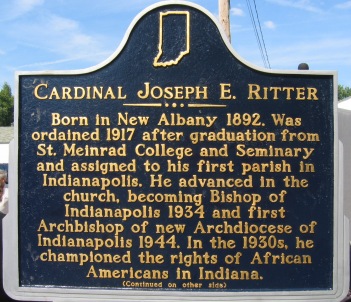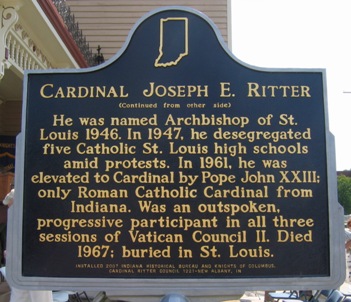

Location: SW corner of E. 13th and E. Oak Streets, New Albany (Floyd County, Indiana)
Installed: 2007 Indiana Historical Bureau and Knights of Columbus Cardinal Ritter Council 1221
ID# : 22.2007.3
Text
Side one:
Born in New Albany 1892. Was ordained 1917 after graduation from St. Meinrad College and Seminary and assigned to his first parish in Indianapolis. He advanced in the church, becoming Bishop of Indianapolis 1934 and first Archbishop of new Archdiocese of Indianapolis 1944. In the 1930s, he championed the rights of African Americans in Indiana.
Side one:
He was named Archbishop of St. Louis 1946. In 1947, he desegregated five Catholic St. Louis high schools amid protests. In 1961, he was elevated to Cardinal by Pope John XXIII; only Roman Catholic Cardinal from Indiana. Was an outspoken, progressive participant in all three sessions of Vatican Council II. Died 1967; buried in St. Louis.
Keywords
Religion, Education
Annotated Text
Side one:
Born in New Albany 1892. (2) Was ordained 1917 after graduation from St. Meinrad College and Seminary (3) and assigned to his first parish in Indianapolis. (4) He advanced in the church, (5) becoming Bishop of Indianapolis 1934 (6) and first Archbishop of new Archdiocese of Indianapolis 1944. (7) In the 1930s, he championed the rights of African Americans in Indiana. (8)
Side two:
He was named Archbishop of St. Louis 1946. (9) In 1947, he desegregated five Catholic St. Louis high schools amid protests. (10) In 1961, he was elevated to Cardinal by Pope John XXIII; (11) only Roman Catholic Cardinal from Indiana. (12) Was an outspoken, progressive participant in all three sessions of Vatican Council II. (13) Died 1967; (14) buried in St. Louis. (15)
Notes:
(1) The 1900 Census gives Ritter's name as Elmer (B050459). St Meinrad's annual catalogues from 1909 to 1917-1918 give his name as Elmer (B050456). On March 24, 1933, he was made the Bishop of Hippos and Auxiliary to the Most Rev. Joseph Chartrand, D.D. Indiana Catholic and Record, March 31, 1933 (B050512). After that time he was referred to as Joseph E. See, for example, Ibid., April 27, 1934.
The formal term of address in the Roman Catholic Church is Joseph Cardinal Ritter.
(2) Ritter's birth date was July 20, 1892. Social Security Death Index Record, http://search.ancestrylibrary.com (accessed June 16, 2006) (B050460).
The 1900 U.S. census lists the Ritter family living at 1218 Oak St. Ritter was 7 years old at the time. U.S. Bureau of the Census, Twelfth Census (1900), Schedule 1, Population, New Albany, Floyd County, Indiana, p. 14B (B050459).
The Indiana Catholic and Record printed a picture of this home on Oak Street in New Albany and indicated that it was the location where Ritter was born. Indiana Catholic and Record, March 31, 1933 (B050783).
The Cardinal Ritter Birthplace Foundation is currently restoring the house with the assistance of the Historic Landmarks Foundation of Indiana. The Birthplace Foundation's Web site is www.cardinalritterhouse.org.
(3) Ritter attended St. Mary's parochial school. "Joseph Cardinal Ritter, " Men Who Make the Council (South Bend, 1964), 11 (B050770).
"He and a friend Herman Emlinger, decided, when they were students in the seventh grade, that their vocations were clear. They went to the assistant pastor at St. Mary's and told him they wanted to become priests. He advised them to finish grammar school and then enter St. Meinrad's seminary." This source is a wonderful reminiscence by two New Albany residents about Ritter as a boy "playing priest." Indiana Catholic and Record, March 31, 1933 (B050783).
Ritter was ordained May 30, 1917. "Seminarium S. Meinradi, O.S.B., " May 30, 1917, Box 13, Joseph Elmer Ritter Collection, Archives Office, Archdiocese of Indianapolis (B050771).
(4) On July 3, 1917, Ritter was as assigned assistant priest to the parish of St. Patrick's, Indianapolis. "Diocese of Indianapolis, " July 3, 1917, Box 1, Joseph Elmer Ritter Collection, Archives Office, Archdiocese of Indianapolis (B050773).
(5) On October 12, 1917, Ritter came to S S. Peter and Paul Cathedral, Indianapolis, as second Assistant. Indiana Catholic and Record, March 31, 1933 (B050512) and James Johnson, "Joseph Cardinal Ritter, Men Who Make the Council (South Bend, 1964), 12 (B050770).
On August 21, 1925, Ritter was appointed Rector of Cathedral Parish. "Diocese of Indianapolis, " September 1, 1925, Box 1, Joseph Elmer Ritter Collection, Archives Office, Archdiocese of Indianapolis (B050777).
On January 3, 1930, Ritter was nominated to the office of diocesan consultor. Letter, Most Reverend Joseph Chartrand to Ritter, January 3, 1930, Box 1, Joseph Elmer Ritter Collection, Archives Office, Archdiocese of Indianapolis (B050774).
On March 24, 1933, Ritter was consecrated Bishop of Hippos and Auxiliary to Most Reverend Joseph Chartrand, D.D. Indiana Catholic and Record, March 31, 1933 (B050512).
(6) Ritter's enthronement as Bishop was April 24, 1934. Indiana Catholic and Record, April 27, 1934, p. 1 (B050543). "Decretum, " Apolostic Delegation, Washington, D. C., United States of America, April, 1934. Box 8, Joseph Elmer Ritter Collection, Archives Office, Archdiocese of Indianapolis (B050779).
(7)Ritter was made the first Archbishop of Indianapolis. "The Establishment of the Ecclesiastical Province of Indianapolis and the Installation of the Most Reverend Joseph Elmer Ritter, D.D., as Archbishop of Indianapolis by his Excellency the Most Reverend Amleto Giovanni Cicognani, D. D., J.U.D., " December 19, 1944 (B050462).
The Archdiocese of Indianapolis was established the same day. Ibid.
(8) During the late 1930s, Ritter worked hard for civil and social rights of African Americans in Indiana, and as vice-president of the official diocesan newspaper, Indiana Catholic and Record. See, for example, Indiana Catholic and Record, September 17, 24, October 1, 8, 1937 (B050787, B050786, B050511, B050510).
There are various references that say Ritter desegregated the parochial schools of Indianapolis, but no specific primary source documentation has been located to substantiate that. See, for example, Harold A. Buetow, "The Underprivileged & Roman Catholic Education, " The Journal of Negro Education, 40 (Autumn 1971), 373-89 (B051037); Hartford Courant, January 23, 1961 (B051035); Hartford Courant, December 27, 1964 (B051036); Washington Post, June 11, 1967 (B051034).
A possible explanation may be that in 1937, the Catholic Interracial Council in New York passed a resolution that all children, regardless of race or economic situation, have a God-given right to a Catholic education. It was during this same time that Ritter formed a committee to investigate and study the social needs of African Americans in Indianapolis. Indiana Catholic and Record, October 1, 8, 1937 (B050510) (B050511).
Father John LaFarge, SJ, together with George Hunton, founded the New York Catholic Interracial Council movement in 1934. Apart from the leadership given by these priests and hierarchy, it was the voice of the laymen organized in Catholic Interracial Council movements that formed the strongest concerted effort within the Church to implement racial equality. Traxler, Sister Margaret Ellen, "American Catholics and Negroes, " Phylon, V. 30, 4 (Atlanta, 1969), 355-66.
9) On July 27, 1946, it was announced that Archbishop Ritter had been named as Archbishop of St. Louis. "Archbishop Goes to St. Louis, " Indiana Catholic and Record, August 2, 1946 (B050539). Ritter was installed on October 8, 1946 at the Cathedral of St. Louis. Indiana Catholic and Record, October 11, 1946 (B050538).
(10) In September 1947, Ritter desegregated five Catholic St. Louis high schools; as a result, the City Board of Education immediately advocated the abolition of segregation in St. Louis public schools. Indiana Catholic and Record, September 19, 1947 (B051033).
Ritter threatened those who fought desegregation with excommunication from the Catholic Church, making it easier for him to implement change and to eliminate opposition. Indiana Catholic and Record, September 26, 1947 (B050524).
(11) On January 19, 1961, Ritter was elevated to Cardinal by Pope John XXIII in St. Peter's Basilica, Vatican City, Rome, Italy. The Criterion, January 20, 1961 (B050506). "Four major accomplishments of Cardinal Ritter's career were singled out: (1) his sending of priests of the St. Louis Archdiocese to work in the South American mission field; (2) his early integration of parochial schools; (3) his work in promoting the participation of the laity in the Apostolate; and (4) his outstanding service as the head of the Commission for the Liturgy."
(12) He was the first and to date is the only Roman Catholic Cardinal from Indiana. E-mail, Karen Oddi, Associate Archivist, Archives Office, Archdiocese of Indianapolis to IHB, November 15, 2006 (B051042).
(13) Ritter was an outspoken, progressive participant in all three sessions of Vatican Council II. Indianapolis Star, October 13, 1964 (B050501); The Criterion, October 9, 1964 (B050502); Xavier Rynne, Letters From Vatican City, Vatican Council II (First Session [October 11, 1962 to December 8, 1962]): Background and Debates (New York, 1963), 116 (B050529).
Rynne provided the following passage: "Seeing the way the wind had been blowing during the past few days, with determined expressions of opinion by such eminent figures as Cardinals Frings of Cologne, Doepfner of Munich, Dio of Tokyo, Leger of Montreal, Ritter of St. Louis, and Myer of Chicago, as well as African bishops almost a body, in favor of changes of all kinds, particularly regarding the use of vernacular in the mass, the restoration of communion under both kinds on special occasions, and so on, Cardinal Ottavani rose to ask, "Are these fathers planning a revolution." Xavier Rynne, The Second Session, The Debates and Decrees of Vatican Council II, September 29 to December 4, 1963 (New York, 1964), 72, 181 (B050534).
Rynne also noted: "Two important interventions on Thursday emphasized the importance of an even greater biblical approach and of theology of the Word, relatively new ideas in recent Catholic theology. The first by Cardinal Ritter, Archbishop of St. Louis—the second American to speak in the session." Ibid., 72.
Rynne wrote further: "Though the Council meeting on the following day, November 7th, was marked by the important intervention of Cardinal Ritter of St. Louis . . . ." Ibid., 181.
During the last session there was a major dispute, and Ritter was right in the middle: "If the Americans were faulty in not being sufficiently vigilant, they made up for this defect by their reaction, which was immediate, violent, spontaneous, and for once instinctively well organized." Xavier Rynne, The Third Session, The Debates and Decrees of Vatican Council II, September 14- November 21, 1964 (New York, 1964, 1965), 64-65, 73, 149, 230; quotation on 259 (B050528).
(14) Ritter died on June 10, 1967. Joseph Cardinal Ritter, Archbishop of St. Louis: Liturgy of Commendation and Farewell, St. Louis Cathedral, June 15, 1967. Box 1, Joseph Elmer Ritter Collection, Archives Office, Archdiocese of Indianapolis (B050769).
(15) Ritter was buried in St. Louis Calvary Cemetery, St. Louis. The Criterion, June 23, 1967 (B050488).
In 1967, St. Louis University established the "Cardinal Ritter Foundation for Human Rights and Social Justice, " The Criterion, June 30, 1967 (B050487).
In 2006, Andrew Steffen, Indianapolis attorney gave a one million dollar scholarship endowment to Marian College, Indianapolis, to increase diversity at the college, in honor of the legacy of Cardinal Ritter. The Criterion Online Edition, February 24, 2006, http://www.archindy.org/criterion/local/2006/02-24/ritter.html (accessed June 19, 2006) (B050486).
